Exhibition organised to raise money for

Archive Home Page
Previous Exhibition Following Exhibition
St. Margaret's Hall, Coniston Road, Hatherley, Cheltenham, GL51 3NU
Exhibition organised to raise money for |  |
Descriptions are based on material supplied by the layout owners
Aldermouth Aldermouth is a totally fictitious layout portraying a Great Western Railway (GWR)branch line terminus during the period 1930 to 1940. The scenario is running rights have been granted to the Southern Railway (SR) and a variety of both GWR and SR locomotives together with passenger and goods stock are in evidence. There are a number of factories and warehouses in the Aldermouth area, with some based on the towns canal front. Rail traffic is always busy, there is considerable movement of mixed goods traffic to be seen to and from the industrials, at the same time a fairly intensive passenger service. The motive power used is a mixture of kit built and ready to run locomotives together with steam and diesel Railcars. Coaches are also kit built and ready to run, wagon stock is built from Slater, Parkside Dundas and Peco. The buildings on the layout are a mixture of kit and scratch built and there are also a number of kit built road vehicles reflecting the period modelled. Baseboard total is 17 feet long by 2 feet wide. | 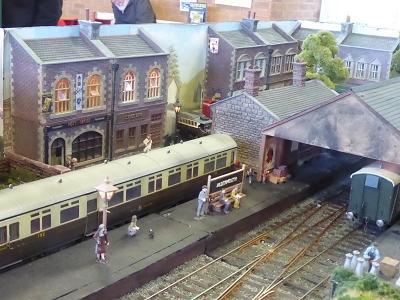 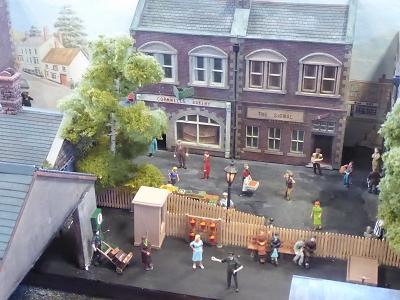 | |
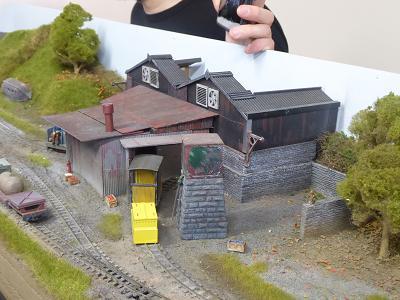 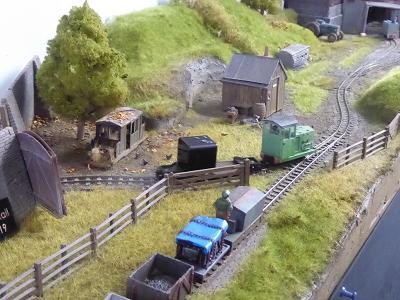 |
A fictional agricultural railway located in the Lake District, modelled in 7 mm scale on 9mm gauge track, representing a 15" gauge. Following the overwhelming popularity of “La’aL Ratty” the Keswick Granite Company decided to utilize a 15 inch gauge railway within a farming setting to assist in taking goods as far as the shores of Derwent Water. The project became surprisingly lucrative, and “tracks” were made to produce a small railway that ran through the landscape, working its way through Castlehead and Cockshot Wood to the shores of Derwent Water on the old coffin route, with a private offshoot reaching the grounds of Castlerigg Manor and its secret walled garden. The majority of the traffic was timber from the two adjacent woods, which would then be sent across Cumbria for use in homes, furniture and boat manufacturing. livestock and general farming “debris” was also sent down the railway. Time ran on, and the railway has dwindled to an unkempt mess, what you see before you is a brief section of the line, located between the two woods along the old coffin route, and the very southern part of the great secret walled garden now used for storage. | |
Blagdon Blagdon was the terminus of the Wrington Vale Light Railway which left the Cheddar Valley Line at Congresbury. The station layout must be one of the simplest possible, requiring only 4 points. Yet it maintains operator interest with a regular passenger service and a small goods yard behind the station. The station building is typical of the style used on the line, the other being of GWR origin. There is no signalling, the branch being worked as one engine in steam. The track and point motors are Peco. The track is well ballasted in and weath- ered. Buildings are made from a mixture of card, plasticard, paper, corrugated foil etc. The stock is a mixture of proprietary and kit built, with a large section of kit built wagons. |  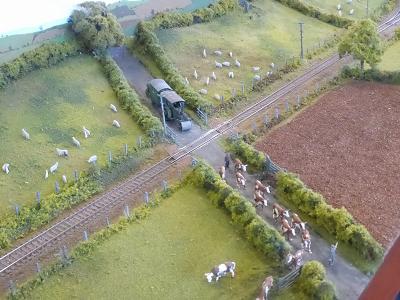 | |
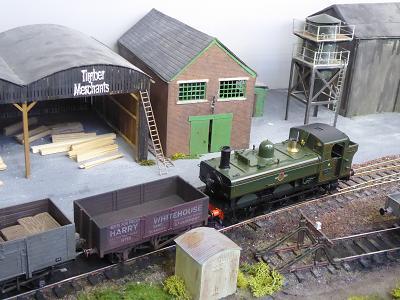 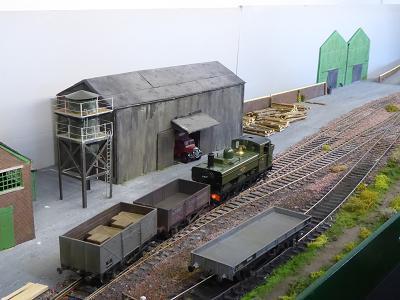 |
Brades Sidings the model railway layout is a representation of a timber yard based in the turnover era between steam and diesel. The goal was to show how with minimal investment a small O gauge layout could be built for exhibition to the public. Rolling stock is a mixture of ready to run and kit built. | |
Caradon Junction Caradon Junction model railway is based on Coombe Junction on the Liskeard to Looe branch in Cornwall. The trains descend a 1 in 40 incline to the junction where passenger trains run into a dedicated small platform. From here they reverse and proceed back through the junction taking the branch line down to Looe, only a small section is modelled but I hope it gives the flavour.
Freight trains, which due to the incline are quite short, are mainly made up of the distinctive china clay hoods. They proceed on a separate track and under the bridge to the clay driers at Moorswater. In reality the driers are much further away than on the model and are generic rather than a copy of those at Moorswater.
The time modelled is in the period around the mid 1970's and early 1980's when blue diesels ruled supreme. Locomotives are represented by class 25, 37 and 52 Westerns. Passenger trains are operated by class 121 "Bubble cars" and all are DCC controlled with sound. The majority of the buildings are scratch built | 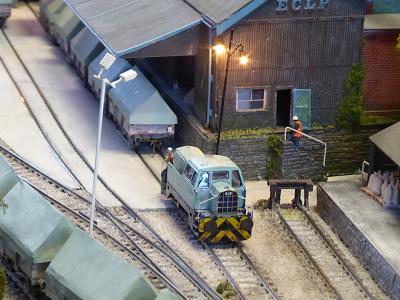 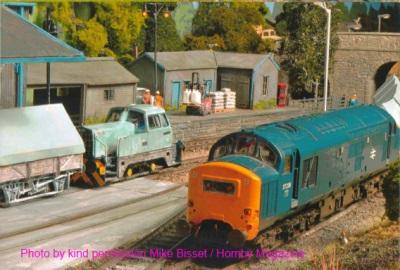 | |
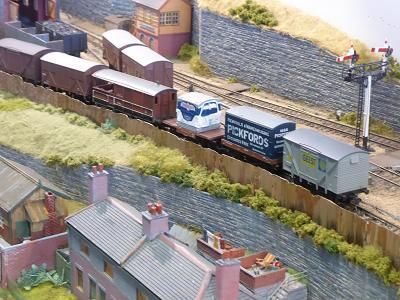 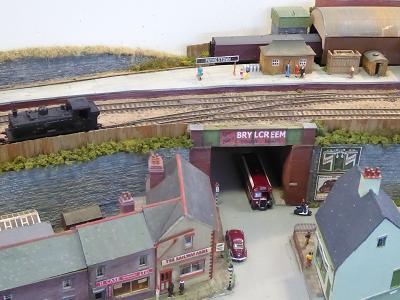 |
Paynestown is a fictional small Western Region terminus set somewhere in the South Wales mining area. Construction is fairly standard Peco code 100 track and points. Buildings are scratch built and control is through Digitrax DCC. | |
Puffin Colliery Puffin Colliery is based in Wales and is served by its own narrow gauge railway which transports the mined coal from the pit head to the transfer point with the main line. A tipper is used before the standard gauge railway transports the black diamonds onward down to the docks. The track is all Peco as are the point motors. The narrow gauge is powered by analogue. The main line is DCC which allows for sound equipped locomotives. We also have a working pit head gear and frame with Winding House. | 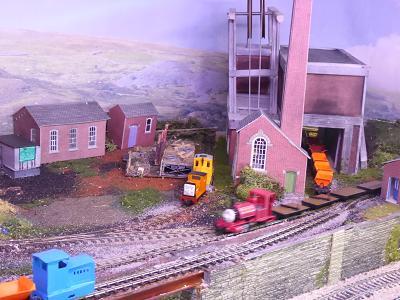 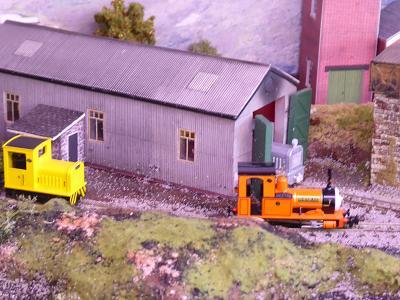 | |
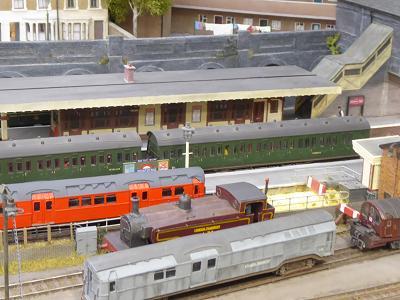 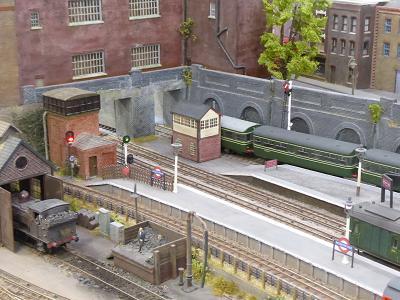 |
Rossiter Rise portrays a fictitious through station somewhere in the suburbs of North West London in the mid to late 1950's. It includes platforms serving London Midland Railway suburban and branch line services, plus a bay platform for London Underground shuttle trains. In front of the station is a small London Transport depot. Many of the structures are scratch built, whilst others are kit built or modified propriety models. The majority of the rolling stock is not ready to run off the shelf, but a collection of unusual and rarely modelled items, including conversions, scratch-built and 3D printed construction. As well as the services mentioned above freight and light engine workings mean that almost anything can make a surprise appearance as motive power! The layout is designed to be operated in such a way that trains are moving. Also the model railway is operated from the front and stock can be viewed waiting in the wings. | |
Snowdon This layout portrays the two foot narrow gauge railway at Rhyd Ddu, the southern terminus of the North Wales Narrow Gauge Railways’ line to Dinas. The station was called Rhyd Ddu until the late 1880’s when it took on the name Snowdon, finally in later years it was called South Snowdon. We have modelled as it is thought to have been in the early part of the 20th Century, and is largely based upon photographs and information found in the Welsh Highland Heritage Magazine. The railway was eventually incorporated into the ill fated Welsh Highland Railway in 1922. However it is now mid point of the new expanding Welsh Highland Railway, which is one of the most impressive narrow gauge railways in the British Isles. Every attempt has been made to model the station building as accurately as possible. However, it has been necessary to shorten the run round loop considerably to keep the layout down to a reasonable size. It has also been necessary to model the area around the station as it might have been, using a degree of modelling license, due to the lack of detailed photographic information away from the immediate station area. As with my earlier Dinas layout, the intention has always been to model everything virtually from scratch, and this has largely been accomplished, the unusual scale of 8mm to one foot leaving little option. The track is spiked to wooden sleepers in the prototypical manner, the ballast being produced from crushed slate. The locomotives operated on the layout were constructed from nickel silver brass, closely following the dimensions on the manufacturers original drawings. Coaches and wagons were constructed from wood, nickel silver or plasticard on nickel silver underframes. Stonework on the buildings has been produced by building up layers of Polyfilla onto a scribed plaster base, the resulting textured finish being painted in water colours. The corrugated iron for the sheds and roofs was produced from Slaters sheet, suitably trimmed and pinned. Grass is made from individual pieces of Gaugemaster grass mat together with static grass. The major structures are now fully completed with internal lighting to show the detail. There are still some areas that are being developed and this will probably continue over the next year or so. It is hoped that it will be possible to connect Snowdon NWNGR to Dinas NWNGR at some time in the not too distant future. This would be total length of 34 feet. | 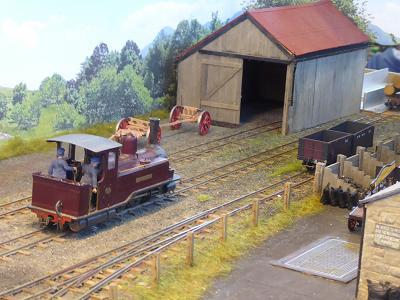 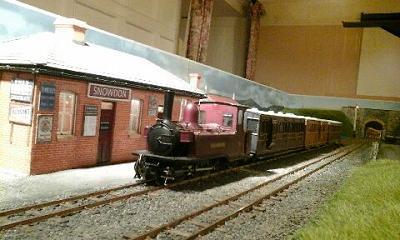 | |
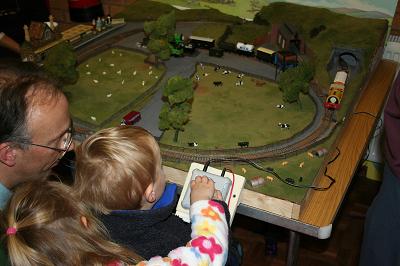 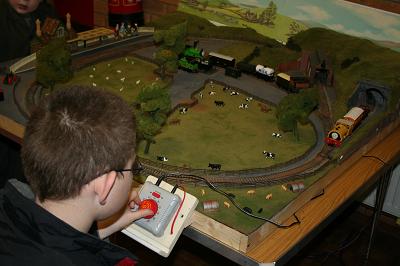 |
We would like to thank Trevor Hallam for looking after the Thomas Layout for many years at our exhibitions and also for refurbishing it at his expense. Unfortunately because of ill health Trevor is no longer able to continue so it was decided to offer Thomas free of charge to Hucclecote Railway Modellers on condition they bring it to all of our future exhibitions. This is the model railway where Children can become Engine Drivers on the Island of Sodor and has of course been inspired by the Reverend Audrey books. Our Thomas and Friends layout has been built for ten years now and in that time we hope it has encouraged many new railway enthusiasts to build a train set of their own. Originally it was intended as a space filler at shows so needed to be small, easy to transport and have a simple track plan, easy for small children to operate. After its first appearance it was clear this model railway would have to be included at all our exhibitions. It incorporates a tunnel, station, level crossing together with locomotive and goods facilities. Train drivers should look out for many of the popular characters; Henry, Percy, Toby, Cranky, the Troublesome Trucks, not forgetting the Sir Topham Hatt better known as the Fat Controller. The famous anthropomorphised rolling stock is mostly from the Thomas range and we are sure most of the adults and all the kids will love it. Happy Driving, but please observe the track speed limits. | |
Whitedown MPD Whitedown Motive Power Depot, the model railway is a fictious location set in North East Hampshire on British Railways Southern Region. The layout was originally built in the early 1990's by one of our club members who unfortunately passed away in March 2016. | have had the great honour of rebuilding his first exhibition layout back to working order. Expect to see a very wide range of Steam and Diesel locomotives with many modern image motive power on displayed. We do not operate to any set sequence, Whitedown is exhibited to show the variety of Steam and Diese! locomotives that have run with the various companies from approximately 1930 to present day. | 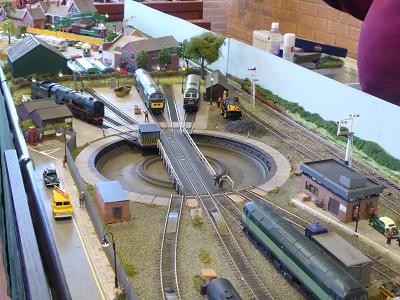 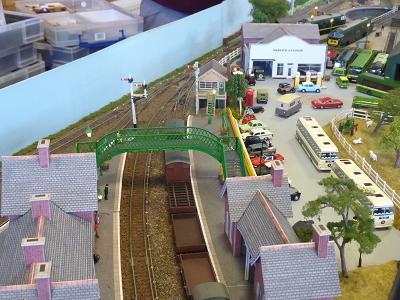 | |
| Displays | ||
Model Bus Federation WEBSITE | NARTM (road transport) WEBSITE | |
Travel 2000 Ltd | Mini scenes | |
Abbotswood - the back room story | Gloucestershire Warwickshire Railway WEBSITE | |
Universal Works - Integration Station WEBSITE | The Gloucester Seven | |
1960s BRS Depot | Return to the rails | |
| Modelling Demonstrations | ||
| John Emerson, O gauge | Mark Begley | |
| Richard Self | Steve Harrod | |
| Trevor Hale | ||
| Trade | ||
| Cheltenham Model Centre WEBSITE | Martin Lewis Model Railways | |
| RCSW (Pre-owned) Models, Clive Reid | Rly books, timetables, photos, Stewart Blencowe WEBSITE | |